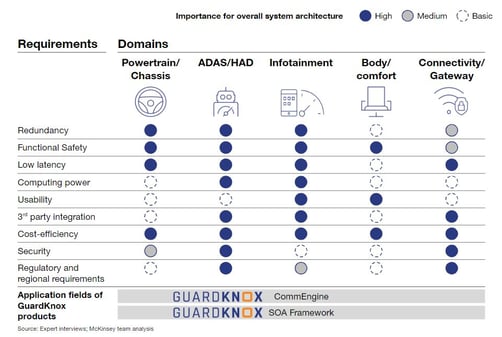What's Keeping Software-Defined Vehicles From Their Full Potential?
February 28, 2023
The day when our cars offer the same services, personalization, and customization as our smartphones is closer than ever. As a result of the ongoing transformation of vehicles from being mainly hardware-based to a software-centric device on wheels, the automotive industry is shifting towards the Software-Defined Vehicle and, ultimately, cars are ‘smartphonizing’.
- E2E solutions that can deploy software updates and new features to existing vehicles.
- A standardization of middleware frameworks across all domains.
- Shorter time-to-market for the deployment of new features and updates.
Overcoming these challenges will give all relevant stakeholders in-vehicle software development the freedom and flexibility to develop and deploy new applications across all 5 vehicle domains. Developers need to be able to focus on new applications while cutting down the complexity and time it currently takes to do so.
Challenge #1: End-to-end (E2E) Software Deployment Solution
The way vehicles are developed today relies on a software framework in which hardware and software are tightly coupled. This means that once production begins - and certainly once the vehicle has left the factory - it requires a complex process to upgrade or add new features and capabilities in a secure and safe manner.
To address this challenge, vehicle hardware, and software need to be decoupled. Recent approaches such as AUTOSAR have taken the first steps in this direction by creating a software architecture with middleware to allow communication abstraction to occur. These approaches are still very dependent on the basic software underneath the middleware which is tightly coupled to the ECU hardware and Tier 1 manufacturer thereof. A “multi-ware” approach is needed to further abstract the actual vehicle compute hardware. Once this happens, it will be much easier for OEM and Tier 1 to develop and implement automotive services or applications in the vehicle: services can be sent Over-the-Air (OTA) and installed in the vehicle using the relevant resources and interacting in the appropriate manner across components and devices without requiring the architects to define all the interactions in advance.
Today, a car’s functionality is often based on its model year. For example, the 2022 version of a certain type of car is likely to have new features that were unavailable for the 2019 model. If a driver wants the latest software features or experience offered in a specific vehicle line, they need to purchase the latest model, which can get costly. In an SDV, OEMs and software engineers will need to operate in a state of continuous software development resulting in features that can be deployed OTA no matter where a vehicle is. This will dramatically increase the lifespan of vehicles while also creating new revenue streams for OEMs.
“All (automotive) domains develop their own software and then fail when an E2E function is needed. I am not even speaking about the subsequent updates.”
–Sr. Manager Engineering E/E, OEM
Adding a “multi-ware” layer to the platform provides not just communication abstraction but takes the next logical step in automotive hardware abstraction. A broader decoupling of the hardware platform and applications is one way to radically reduce the complexity of the application development process and significantly shorten the time to market of new features.
Challenge #2: Accommodation of Middleware Frameworks Across All Domains
The second challenge is finding a solution for E2E functions that play across all domains and supports legacy middleware approaches. Currently, vehicle middleware is tailored to specific domains like ADAS or to specific integrations like AUTOSAR or ROS. This made sense when each domain was created separately and intended to operate on its own or when services were developed for a target OS or limited in the number of devices, interfaces, and software components they sent and received data from.
“All solutions have a certain sweet spot - some try to integrate well with AUTOSAR, some with ROS. This is not what you want to have given the overall goal of standardization.”
– Head of Security Architecture and Infotainment Systems, Premium OEM
In an SDV, however, there is less of a separation between each domain, and having different domains relying on separate architectures that are unable to communicate with each other limits developers’ ability to create new applications quickly. SDVs must, therefore, have domain-independent usability while still conforming to security and safety requirements.
A domain-agnostic multi-ware solution will provide OEMs with:
- Cost savings - with multiple teams leveraging a platform that allows domain-agnostic development and in-built support of legacy approaches, they can reduce their learning curve, work more efficiently, and enable the reuse of assets, saving significant time and money.
- Reduced integration time - with no need to integrate from one domain-specific middleware to another, fewer steps are involved keeping the process shorter and more efficient.
The above will lead to a faster time-to-market for new features which is of key importance to remaining competitive.
Challenge #3: Efficient Software Development Tools
The existing software development tools on the market today are still rudimentary, leading to complex workflows which often result in time-consuming software development and integration efforts. As one Lead Software Architect for AD/ADAS at a Tier 1 shared: “My programmers are definitely missing a middleware solution with a dedicated toolset. We must often come up with suboptimal solutions, write our own tooling and lose time.”
Access to a broad set of state-of-the-art development tools as well as post-deployment analysis tools enables a new developer ecosystem that would be much more efficient and significantly reduce time-to-market. Instead of creating new software from scratch for each new feature and function, developers would have access to a library of predefined components available for reuse.
The Solution: Domain-Agnostic Multi-Ware Connecting All Devices and Software Components
Guardknox’s Secure SOA Framework is a comprehensive software lifecycle management solution for the next generation of SDVs. It is domain-agnostic
and provides a dedicated developer tool suite that streamlines software development and reduces the time to market for new features from years to months or even weeks.
Specifically, the SOA Framework addresses each of the key challenges in the following ways:
- Provides hardware abstraction, allowing for commonality between different hardware platforms and the reuse of software components.
Standardizations of Frameworks Across all Domains:
- Manages the entire software lifecycle securely, while also monitoring software health to enable compute load balancing through all vehicle computational resources to reduce HW components.
- Supports Heterogeneous Operational Environments including a variety of Transport Middleware, Operating Systems, Hypervisors, and Embedded Devices.
- Allows seamless and secure integration of cloud-based, edge, and hybrid applications and data, enabling the implementation of value-added services and on-demand features that can easily grow together with the infrastructure around it.
Efficient Software Development Tools:
- Creates a secure, manageable, and updateable multi-ware platform, offering 3rd party application developers the to use standard APIs in a virtual cloud-based environment.
Overall, the SOA Framework reduces time-to-market for OEMs and Tier 1s with a product tool suite that offers modeling, automatic code generation, and analysis of new features and functionalities as well as reuse of SW components without recertification.
Enabling the Vehicle of the Future Across All Domains and Models
With SDVs as the car of the future, significant changes are needed to the way the industry approaches automotive software development, deployment, and ongoing management through the vehicle and software lifecycle.
Guardknox’s SOA Framework provides a domain-agnostic solution for full lifecycle management of software across the entire vehicle value chain and lifetime, from vehicle and system development thru manufacturing, shipping, sale, and post-production. Having the ability to add new features post-production is critical for allowing OEMs to strengthen their relationships with drivers while also generating new revenue streams via customized experiences.
For more information about the SOA Framework, please contact us.






